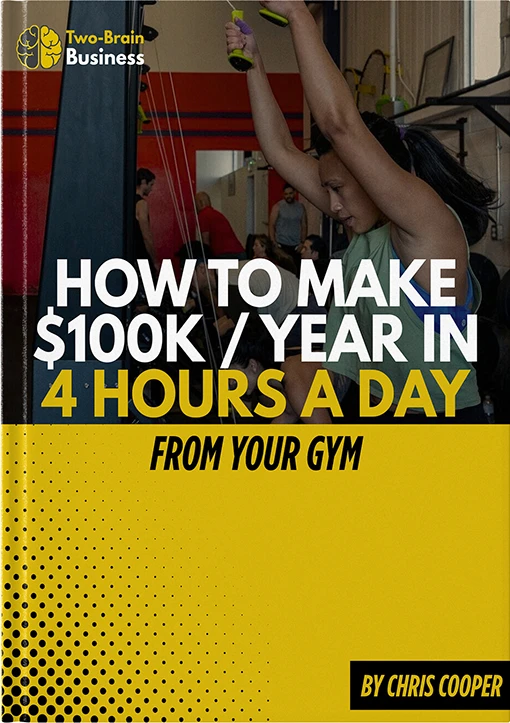“Summer revenue slumps are inevitable.”
Ever said that?
Many gym owners have because they know June, July and August are months in which:
- Many clients take time off work—and the gym.
- Many clients travel for vacations.
- Weather is nice and people skip workouts in favor of beer on the deck.
- Kids are out of school.
- Routines get disrupted.
You can’t change any of that stuff, but you can create new opportunities instead of bracing for impact.
I’ll give you five ways to do that, plus a tip.
ProTip: Change Your Schedule Quarterly
Attendance patterns change throughout the year. So you’ll want to change your schedule to serve clients better and ensure you don’t have empty sessions.
If you always adjust your schedule quarterly, clients will come to expect it, and changes won’t be jarring.
Here’s how to do it: “Changing Your Schedule.”
Tactic 1: Pre-Sell a Fall Engagement (Now)
People don’t quit or hold memberships if they’re working toward a clear goal—so ensure they have something on the calendar, such as a September in-house competition, a fall specialty program or a nutrition challenge.
Start selling registrations today. If you do, you’ll generate revenue that will buffer any summer declines, and members will be far less likely to skip workouts or cancel memberships.
Sample wording: “’Sign up now, train all summer and compete in September.
Prompt to help you get started: What’s one thing you could put on the calendar for September that would get your clients excited today?
Tactic 2: Add Seasonal Offers for New and Current Clients
It’s a mistake to think “summer is dead in here so I won’t do anything special.”
Summer might be dead because you don’t do anything special.
Here are three ideas for seasonal events:
Couch to 5k Program
- Market to beginner runners and people outside your gym.
- Sell in-person group coaching and a remote option for members on the road.
- Build relationships with local run clubs or race organizers to connect with new audiences.
Summer Bingo
- “Gamification” can create a fun retention play: “Complete these tasks over the summer and win a prize.”
- Example tiles: Attend class three times a week, bring a friend to a workout, try a new skill, post a sweaty selfie on Instagram, etc.
Summer League
- Create team-based fitness games for July and August.
- Keep it light and social but include a competitive twist. Example: Tuesday Time Trial, in which members do a run, bike, ski or row piece and receive a ranking—and a prize.
- Charge a small fee for participation and offer team shirts or prizes.
Prompt to help you get started: What would make your gym the place to be over the summer, even when people are tempted to drift away?
Tactic 3: Capture Extra Revenue With Offseason Athletes
When sports teams are in their offseason, you have a golden opportunity to help members get fit and perform better next year. Strike when the iron is hot: Market strength and conditioning to youth teams or athletes whose seasons just ended.
Depending on the timing in your area, prime sports include baseball, soccer, hockey, volleyball, basketball, track and field, and cheer.
Pay special attention to “school sports” that have loyal participants who can’t compete in summer. For example, in some areas, basketball season ends in late spring, so summer programs for the hoops crowd can be a huge win. But you can also target older athletes, such as rec-league hockey players who’d like to be ready for fall.
A clever twist: Offer a remote training option including workouts, accountability check-ins and nutrition tips.
Here’s a big bonus: Summer sports programs allow you to build long-term relationships with parents and local sports clubs. You might be able to create a very strong revenue stream or referral network.
Prompt to help you get started: Who in your local community could use help this summer, and how can you reach them this month?
Tactic 4: Give Clients a Summer Prescription
Don’t just hope clients stay engaged—give them a plan.
I love this two-pronged approach:
- If they’re staying home, focus on attendance goals and a progress plan.
- If they’re going away, shift to a remote option or a vacation workout plan.
Hang your plan on Goal Review Sessions. Make sure they have goals for the next months, then supply the plan to keep them on track. Frame this as helping them stay consistent, not trying to sell them more stuff.
Prompt to help you get started: Are you asking your clients what their plans are this summer—or are you just waiting to see who disappears?
Tactic 5: Vacation Plan—Don’t Lose Them While They Travel
Vacations are unavoidable—but they don’t have to cause a cancellation or hold.
If clients will be away, say this: “’Here’s how to stay on track while you’re away.” Then provide:
- Body-weight workouts or workouts using minimal gear they have access to.
- A vacation workout checklist, which can also include non-exercise activities so they score wins when they hike, kayak, swim, etc.
- An optional text check-in or weekly accountability email.
Remember, remote coaching is better than zero engagement. A plan like this shows you care enough to go the extra mile and ensure your clients keep moving toward their goals, even if they’re enjoying some time away.
Prompt to help you get started: How did one of your clients stay engaged on vacation and avoid backsliding to come back to the gym with momentum?
The Summer Slump Is Optional
The summer slump is only inevitable if you do nothing.
I’ve given you five simple, high-reward tactics here. If you’re proactive, you can preserve revenue in summer and even increase it. Yes, I’ve seen focused gym owners create impressive revenue streams with summer programs.
Pick one of these strategies and put it into action this week.
Then look ahead to 2026 and take action so your summer slump becomes a summer surge.

